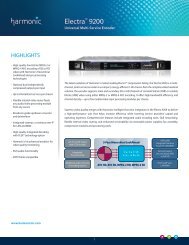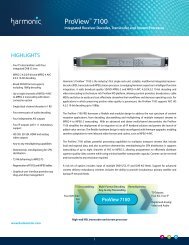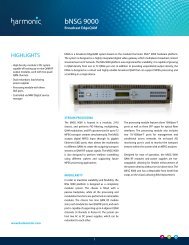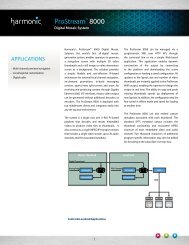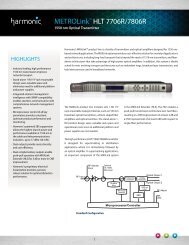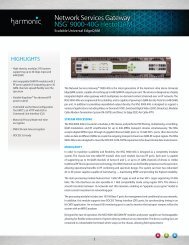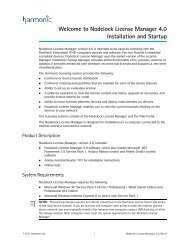NSG 9000-6G - Harmonic Inc
NSG 9000-6G - Harmonic Inc
NSG 9000-6G - Harmonic Inc
Create successful ePaper yourself
Turn your PDF publications into a flip-book with our unique Google optimized e-Paper software.
Chapter 3 Configuring Platform Parameters<br />
Input GbE Ports Configuration<br />
4. In the IP Addresses table, enter the following parameters:<br />
IP Address1 - type in the required IP address<br />
Subnet - type in the required subnet mask.<br />
3.10.2 Configuring Input GbE Port Redundancy<br />
3.10.2.1 Overview<br />
<strong>NSG</strong> <strong>9000</strong>-<strong>6G</strong> supports 1:1 and N:1 redundancy modes for its GbE input ports. Typical port<br />
redundancy configuration depends on the application in which the <strong>NSG</strong> is deployed as the<br />
following scenarios describe:<br />
• VOD application - to allow redundancy for IP unicast VOD streams, you should use 1:1<br />
port redundancy. Select a distinct backup port for each primary port, with the Same IP<br />
Address option checked.<br />
• Broadcast application - to allow redundancy for IP multicast streams, you should use 1:1<br />
port redundancy.<br />
• SDV application - to allow redundancy for IP multicast SDV streams, use either 1:1 or N:1<br />
redundancy modes depending on the desired level of protection:<br />
<br />
<br />
1:1 port redundancy - define for each primary port a backup port. De-select the Same<br />
IP Address option, and set a distinct IP address for the designated backup port. This<br />
mode ensures the highest level of protection against various network failures.<br />
N:1 port redundancy - allows an efficient use of the eight available input GbE ports,<br />
by utilizing a single backup port for protecting several primary ports. The typical and<br />
recommended configuration for this mode is to define two groups of 3 primary ports<br />
and one backup port. For example, port 4 backs up ports 1-3 and port 8 backs up<br />
ports 5-7. In case of a redundancy switch, the backup port starts transmitting also the<br />
streams of the failed primary port(s).<br />
In general, the following guidelines apply for the port redundancy feature:<br />
• To configure port redundancy, port should be enabled. (Select GbE Port > General tab)<br />
• A primary port cannot serve as a backup port.<br />
• If the Same IP Address option is selected, the backup port is disabled and the IP address of<br />
the port changes to the IP address of the primary port. When the primary port fails, the<br />
backup port is enabled, using the same IP address of the failed port.<br />
• Configuring port redundancy, blocks the port configuration except for IP address in case<br />
Same IP Address is selected.<br />
• Alarm configuration:<br />
<br />
<br />
<br />
<br />
<br />
By default both Link Down and No Input Traffic alarms trigger port redundancy.<br />
The alarm configuration of the primary port and backup port is the same.<br />
You can configure the alarms of a primary port only.<br />
When selecting a backup Port, the alarm configuration of the primary port also<br />
applies to the backup port.<br />
In N:1 port redundancy, the alarm configuration applies to the backup port and to all<br />
of the primary ports it backs up. Once you configure the backup port to backup an<br />
additional primary port, the alarm configuration automatically applies to the primary<br />
port. <br />
Any changes to the alarm configuration immediately applies to the backup port and<br />
to all primary ports it backs up.<br />
© 2012 <strong>Harmonic</strong> <strong>Inc</strong>. 37 <strong>NSG</strong> <strong>9000</strong>-<strong>6G</strong>, Version 2.7, Rev B




